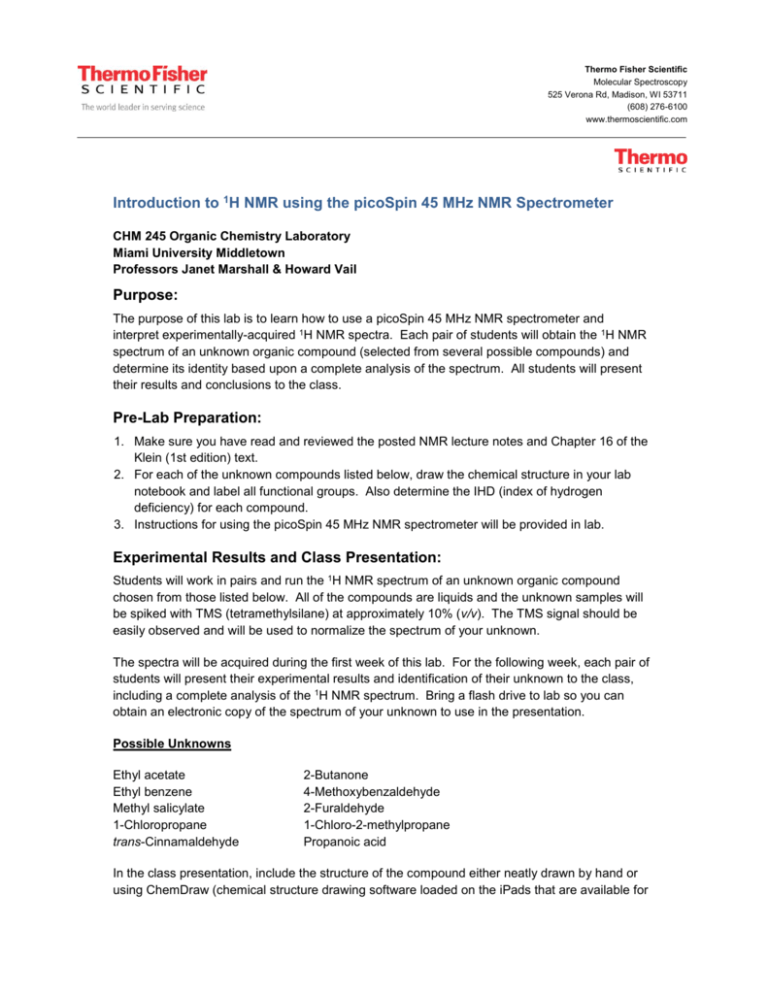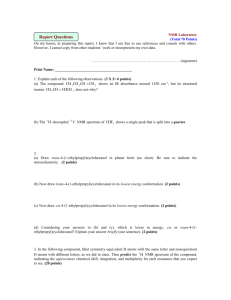Introduction to 1H NMR using the picoSpin 45
advertisement

Thermo Fisher Scientific Molecular Spectroscopy 525 Verona Rd, Madison, WI 53711 (608) 276-6100 www.thermoscientific.com Introduction to 1H NMR using the picoSpin 45 MHz NMR Spectrometer CHM 245 Organic Chemistry Laboratory Miami University Middletown Professors Janet Marshall & Howard Vail Purpose: The purpose of this lab is to learn how to use a picoSpin 45 MHz NMR spectrometer and interpret experimentally-acquired 1H NMR spectra. Each pair of students will obtain the 1H NMR spectrum of an unknown organic compound (selected from several possible compounds) and determine its identity based upon a complete analysis of the spectrum. All students will present their results and conclusions to the class. Pre-Lab Preparation: 1. Make sure you have read and reviewed the posted NMR lecture notes and Chapter 16 of the Klein (1st edition) text. 2. For each of the unknown compounds listed below, draw the chemical structure in your lab notebook and label all functional groups. Also determine the IHD (index of hydrogen deficiency) for each compound. 3. Instructions for using the picoSpin 45 MHz NMR spectrometer will be provided in lab. Experimental Results and Class Presentation: Students will work in pairs and run the 1H NMR spectrum of an unknown organic compound chosen from those listed below. All of the compounds are liquids and the unknown samples will be spiked with TMS (tetramethylsilane) at approximately 10% (v/v). The TMS signal should be easily observed and will be used to normalize the spectrum of your unknown. The spectra will be acquired during the first week of this lab. For the following week, each pair of students will present their experimental results and identification of their unknown to the class, including a complete analysis of the 1H NMR spectrum. Bring a flash drive to lab so you can obtain an electronic copy of the spectrum of your unknown to use in the presentation. Possible Unknowns Ethyl acetate Ethyl benzene Methyl salicylate 1-Chloropropane trans-Cinnamaldehyde 2-Butanone 4-Methoxybenzaldehyde 2-Furaldehyde 1-Chloro-2-methylpropane Propanoic acid In the class presentation, include the structure of the compound either neatly drawn by hand or using ChemDraw (chemical structure drawing software loaded on the iPads that are available for student use from the library). On your drawing, show all hydrogen atoms and label each unique set A, B, C, etc. For the interpretation of your 1H NMR spectrum, assign each observed signal using these labels. Discuss the number of signals, the chemical shift values, integration of the signals, and splitting (multiplicity), including coupling constants (J values) if observed and interpretable. Turn in a copy of your 1H NMR spectrum with the unknown code indicated along with your prelab notebook pages. Also prepare a table for the interpretation of your spectrum and identification of your unknown, as shown below. You do not need to write an experimental procedure, observations, or conclusion in your lab notebook. The class presentation, the labeled structure of your compound, and the table showing the interpretation of your spectrum will suffice. Example of Data Presentation 2-Methylpropanoic acid (unknown Z) 1 H NMR Spectral Data Chemical Shift (ppm) Integration Splitting Coupling Constant Assignment 1.16-1.24 6H doublet Jab = 6.7 Hz a 2.44-2.75 1H septet Jab = 6.7 Hz b 11.88 1H singlet c 1 H NMR Spectrum of 2-Methylpropanoic acid Introduction to 1H NMR using the picoSpin 45 MHz NMR Spectrometer 2






